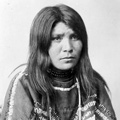The Tsuu T'ina Nation - Social Life

Not all aspects of the Tsuu T’ina lifestyle were serious and work-related. Like the other Natives on the Prairies, the Tsuu T’ina liked to play games, sing songs, and dance. Native games were similar across North America, although they varied slightly based on the climate. Many of the games mimicked the real life activities and duties performed by adults in the tribe, such as hunting buffalo or taking care of youth. Young boys, for example, would make horses out of sticks and pretended to own, steal, and tend to their imaginary animals. Likewise, they would pretend to hunt buffalo, using the girls from the camp as their buffalo prey. Wrestling was a popular activity amongst young boys and adult men, as were other physical activities such as kicking games in which two groups of boys would kick each other until the other team could not stand. Such games helped cultivate strength and perseverance. Little girls, by contrast, would play with life-like dolls made for them by the Elders. The dolls were often made of birch and dressed in clothing, and the girls would care for their little dolls just like the women who nurtured the children in the tribe. Group games were also popular such as a shinny-like game in which two teams would use sticks to hit the ball across the opponents’ goal line. Gambling was also a popular game played by men and women.
The games that children played helped them hone the skills necessary to succeed in adulthood. The games also outline the social roles adopted by males and females. A man’s role was to hunt for buffalo and protect his tribe, while a woman’s domain was in the camp. Women nurtured not only their own children, but also assisted other women in caring for young newborns. They cared for sacred bundles, made pemmican – a staple Native food – and picked berries. Some learned women collected special herbs and plants and acted as herbal healers who cared for the well-being of their tribal members.
Women were also involved in tanning hides, making clothing, and tipi covers. As a means to decorate clothing, they used bone awls and sinew as needle and thread, and used paint and porcupine quills to adorn their garb. Quill-work was a specialized skill that a woman learned from an elder. Often the woman practicing quill-work would be conferred the right to do so and would work under the watchful eye of an older, more experienced quill – worker.
A lot of socializing occurred in the summer time, as this is when bands assembled together into large camps in the prairies. During this time, people would paint their tipis with visions and dreams, transfer medicine bundles, practice potlatch ceremonies, as well as Sweats, and have Sun Dances. By mid-August, the tribes would disperse into the woods where they would follow the buffalo until the following summer.




